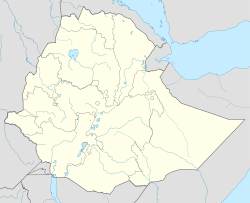- Chalacot
-
Chalacot Location within Ethiopia Coordinates: 13°22′N 39°28′E / 13.367°N 39.467°ECoordinates: 13°22′N 39°28′E / 13.367°N 39.467°E Country Ethiopia Region Tigray Zone Debubawi Elevation 2,100 m (6,890 ft) Time zone EAT (UTC+3) Chalacot or Chelekot is a village in the Tigray Region of Ethiopia. Located in the Enderta woreda of the Debubawi Zone, 10 kilometers north of Antalo and 17 kilometers south of Mek'ele, the village has a latitude and longitude of 13°22′N 39°28′E / 13.367°N 39.467°E with an approximate elevation of 2100 meters above sea level. The Central Statistical Agency has not published an estimate for this village's 2005 population.
History
Chalacot is mentioned in a charter written in 1794, when Emperor Tekle Giyorgis made a grant to Meqdese Selassie Church in the village; the document mentions seven properties.[1] Ras Wolde Selassie made Chalacot his capital, and received Henry Salt there in 1810. The Ras built a palace in the village, as well as houses for his wives and the church Chelekot Selassie, which Philips Briggs described as an "architecturally impressive example of the circular tikul styles of paintings" and "covered in beautiful 19th-century paintings".[2] When Wolde Selassie died in Chalacot (1816), his nephew Walda Rufa'el sacked it.[3]
The town had recovered its former prosperity by the 1840s when Ferret and Galiner visited it; they described it as "one of the principal towns" of Ethiopia, with a population of 3,000 living in well-constructed houses and well-kept gardens. However, a little more than generation later Chalacot had declined; Guglielmo Massaia found only 200 houses with about 1,000 inhabitants and in the 1880s Augustus B. Wylde reported he counted only 80 houses there. The town suffered further losses during the First Italo–Ethiopian War according to Richard Pankhurst, who included Chalacot in a list of northern Ethiopian towns affected by the "disturbed conditions of the times."[4]
Notable inhabitant
Chelekot is the birth place of Ras Araya Dimtsu of Enderta chief crown counciler to Emperor Yohavenss IV of Ethiopia 1867-1889. Ras Araya was also an influential governor of Tigray and Akale Guzay. He died at the battle of Metema while fightinng against the mahdists of Sudan along with Emperor Yohaness in March of 1889. He is the maternal uncle of Emperor Yohaness.
Notes
- ^ "Local History in Ethiopia" (pdf) The Nordic Africa Institute website (accessed 21 April 2008)
- ^ Philip Briggs, Ethiopia: the Bradt Travel Guide, third edition (London: Bradt, 2002), p. 269
- ^ Richard K.P. Pankhurst, History of Ethiopian Towns: From the Middle Ages to the Early Nineteenth Century (Wiesbaden: Franz Steiner Verlag, 1982), vol. 1 pp. 207f
- ^ Richard Pankhurst, Economic History of Ethiopia (Addis Ababa: Haile Sellasie I University, 1968), pp. 691f
Categories:- Populated places in the Tigray Region
Wikimedia Foundation. 2010.

